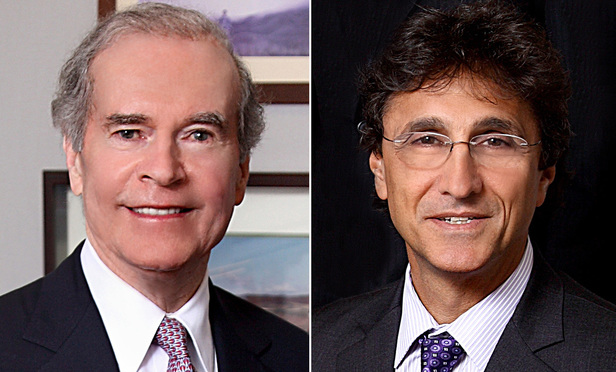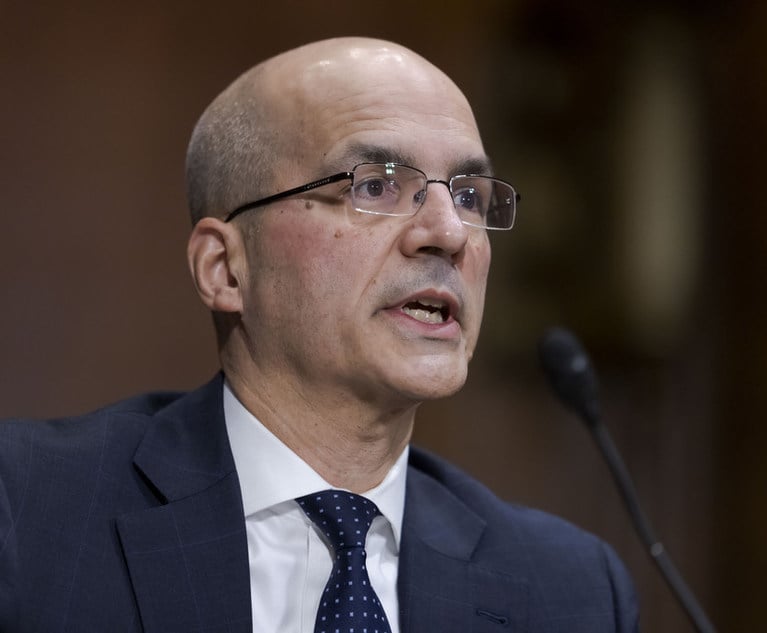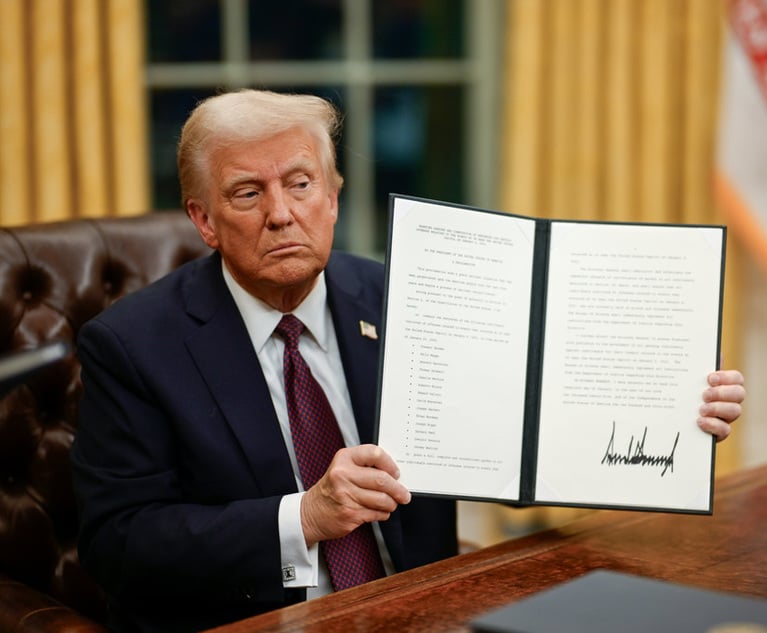Recent Decisions Affecting Discovery
In their Medical Malpractice column, Thomas A. Moore and Matthew Gaier discuss several appellate decisions from the past year addressing the scope of discovery that may have significance for all litigants in personal injury and medical malpractice actions. While these decisions address a broad range of issues, there is an overriding theme involving the impact of advances in technology on discovery.
April 01, 2019 at 02:45 PM
14 minute read
 Thomas A. Moore and Matthew Gaier
Thomas A. Moore and Matthew Gaier
Over the past year there have been several appellate decisions addressing the scope of discovery that may have significance for all litigants in personal injury and medical malpractice actions. While these decisions address a broad range of issues, there is an overriding theme involving the impact of advances in technology on discovery.
Social Media Discovery
In Forman v. Henkin, 30 N.Y.3d 656 (2018), for example, the Court of Appeals addressed the scope of discovery from an injured plaintiff's social media platforms. The plaintiff in that personal injury action alleged that she suffered spinal and traumatic brain injuries that caused cognitive deficits. She testified that she deactivated her Facebook account six months after the accident, and that as a result of her injuries she had become reclusive, had difficulty using a computer, and that a simple email could take hours to write. The defendant sought an authorization to obtain the entire private portion of her Facebook account—that portion of the account accessible only to a member's Facebook “friends,” as distinguished from the public portion of the account, which is accessible to anyone who does an Internet search. The defendant argued that the private portion of the account may have material pertinent to the plaintiff's claim that she was no longer able to engage many activities and to how long it took her to type emails.
A divided Appellate Division, First Department, limited the required disclosure to pre- and post-accident photographs posted on Facebook that the plaintiff intended to use at trial, and eliminated the portion of the Supreme Court's order that required the plaintiff to provide the defendant an authorization to obtain data regarding post-accident messages. In a unanimous opinion, the Court of Appeals reversed, finding that the “threshold requirement” that a discovery request be reasonably calculated to yield information that is “material and necessary” is applicable to the discovery of social media materials.
This effectively overruled the First Department's prior holding in Tapp v. New York State Urban Dev., 102 A.D.3d 620 (1st Dept. 2013), which required defendants seeking disclosure from a plaintiff's Facebook account to establish a factual predicate by identifying information in the account that “contradicts or conflicts with the plaintiff's alleged restrictions, disabilities, and losses, and other claims.” Disapproving of that approach, the court found in Forman that “disclosure turns on the extent to which some of the information sought is already accessible—and not, as it should, on whether it is 'material and necessary … .'” Noting that “the purpose of discovery is to determine if material relevant to a claim or defense exists,” the court rejected the notion that the account holder's privacy settings “govern the scope of disclosure of social media materials.”
The court nevertheless agreed with other courts that “rejected the notion that commencement of a personal injury action renders a party's entire Facebook account automatically discoverable,” noting that this would likely “yield far more nonrelevant than relevant information.” Therefore, rather than “applying a one-size-fits-all rule at either of these extremes,” the court commented that the established rules applicable to discovery generally should be applied to discovery of social media materials:
[C]ourts should first consider the nature of the event giving rise to the litigation and the injuries claimed, as well as any other information specific to the case, to assess whether relevant material is likely to be found on the Facebook account. Second, balancing the potential utility of the information sought against any specific “privacy” or other concerns raised by the account holder, the court should issue an order tailored to the particular controversy that identifies the types of materials that must be disclosed while avoiding disclosure of nonrelevant materials. In a personal injury case such as this it is appropriate to consider the nature of the underlying incident and the injuries claimed and to craft a rule for discovering information specific to each. Temporal limitations may also be appropriate—for example, the court should consider whether photographs or messages posted years before an accident are likely to be germane to the litigation. Moreover, to the extent the account may contain sensitive or embarrassing materials of marginal relevance, the account holder can seek protection from the court … .
Applying these principles, the court found that the defendant satisfied the threshold burden of showing that the plaintiff's Facebook account was reasonably likely to yield relevant evidence, citing the plaintiff's testimony that she had posted “a lot” of pre-accident photographs showing her active lifestyle, which it found was a basis to infer that she may also have posted post-accident photographs of her activities or limitations. It further found it reasonably likely that the data revealing the timing and number of characters in posted messages would be relevant to plaintiff's claim that she suffered cognitive injuries and difficulty writing and using the computer.
Access to Devices
Earlier this year, the First Department returned to discovery of a plaintiff's social media in Vasquez-Santos v. Mathew, 168 A.D.3d 587 (1st Dept. 2019), with potential ramifications that should be disconcerting to all litigants. The plaintiff in that personal injury action had been a semiprofessional basketball player, and alleged he could no longer play due to the injuries he sustained in the subject accident. The defendant moved to compel him to provide a third-party data mining company access to his devices, email accounts and social media accounts to obtain photographs and other evidence of the plaintiff engaging in physical activities. The Supreme Court denied that motion. In modifying that order, the Appellate Division found that while the plaintiff testified that pictures of him playing basketball that were posted on social media after the accident were actually from games he played before the accident, the defendant was entitled to discovery to rebut those claims. It did not matter that the plaintiff did not take the pictures himself but had access to them and others that were sent to his phone by being “tagged.” Citing Forman, the court then directed “access to plaintiff's accounts and devices” that was “appropriately limited in time, i.e., only those items posted or sent after the accident, and in subject matter, i.e., those items discussing or showing plaintiff engaging in basketball or other similar physical activities … .”
The aspect of this decision that should raise concerns for all litigants is the requirement that the plaintiff produce his “devices”—presumably cell phones, tablets and computers—for inspection by a data mining company. This is a new level of discovery that raises significantly greater concerns of privacy invasions. It is difficult to understand why it is not sufficient to provide access to the social media accounts, and why inspection of the devices themselves is necessary.
A rule permitting inspection of such devices has serious implications for defendants as well as plaintiffs, and it extends beyond social media. For example, if a defendant doctor in a medical malpractice action sends texts or emails regarding a plaintiff patient, that would certainly be material and necessary to the lawsuit. The plaintiff would, therefore, be entitled not only to a printout of the texts and emails, but to an inspection of the doctor's cell phone, iPad or computer to “mine” for any such communications. Similarly, a malpractice plaintiff is indisputably entitled to production of his or her electronic medical records from the computer of a defendant doctor or hospital. However, a rule requiring the production of devices would require those defendants to make their computers available for inspection. The list goes on. Is this a road down which we want to travel?
Trail of Electronic Records
Continuing with the theme of discovery stemming from advances in technology, the Second Department, just last week, addressed a medical malpractice plaintiff's demand for an audit trail of the defendant hospital's electronic records. The plaintiff in Vargas v. Lee, ___ A.D.3d ___, 2019 WL 1271883 (2d Dept. 2019), alleged that he had a below-the-knee amputation as a result of a failure to properly treat an ischemic injury after foot surgery at the defendant hospital. The plaintiff moved to compel the hospital to produce the audit trail of the plaintiff's electronic medical records from May 1, 2012 (the day of the surgery) until May 17, 2012. An audit trail is metadata that essentially indicates what changes are made to an electronic record each time it was accessed. The plaintiff argued that this was relevant to the timing and substance of the plaintiff's care. The Supreme Court denied the motion, without prejudice to renew, holding that metadata is not discoverable absent a showing of good cause. The plaintiff renewed, submitting evidence that the hospital had not produced a complete set of the records, but the motion court again denied the requested relief. The Appellate Division reversed.
Citing Forman, the court found that the material submitted upon renewal sustained the “threshold burden of demonstrating that the portion of the audit trail at issue was 'reasonably likely to yield relevant evidence,'” and disagreed with the Supreme Court to the extent that it “determined that a higher threshold burden applied” to the request. The court further found:
[T]he requested audit trail was relevant to the allegations of negligence that underlie this medical malpractice action in that the audit trail would provide, or was reasonably likely to lead to, information bearing directly on the post-operative care that was provided to the injured plaintiff. Moreover, the plaintiffs' request was limited to the period immediately following the injured plaintiff's surgery. The plaintiffs further demonstrated that such disclosure was also needed to assist preparation for trial by enabling their counsel to ascertain whether the patient records that were eventually provided to them were complete and unaltered … .
Physician-Patient Privilege
Leaving the area of technology, the First Department, in Brito v. Gomez, 168 A.D.3d 1 (1st Dept. 2018), addressed the issue of waiver of physician-patient privilege. The plaintiff there alleged that she suffered injuries to her cervical spine, lumbar spine and left shoulder in the subject accident, and sought recovery for lost earnings and loss of enjoyment of life. At her deposition, she testified that she had been in two prior accidents, one which resulted in surgery on her left knee, and another which resulted in surgery on her right knee. The defendants sought authorizations for medical records relating to all treatment on her knees, claiming that they were relevant to her claims for lost earnings and loss of enjoyment of life. A divided First Department rejected that argument.
The majority noted that “[a] party's right to discovery of a litigant's mental or physical condition is subject to the physician-patient privilege,” and that “the privilege is waived where a party affirmatively places his or her physical or mental condition in controversy … .” In that context, it observed that in the case before it, “the specified bodily injuries that are affirmatively placed in controversy are the spinal and shoulder injuries,” and that “[t]he claims for lost earnings and loss of enjoyment of life alleged in the bill of particulars are limited to these specified injuries.” It found that since the plaintiff did not claim that her prior knee injuries were exacerbated or aggravated as a result of the subject accident, neither her claim for lost earnings, nor her claim for loss of enjoyment of life affirmatively placed the condition of her knees in controversy.
The majority acknowledged that its view diverges from that of the Second Department, which has held that a party places his or her entire medical condition in controversy through broad allegations of physical injuries and claimed loss of enjoyment of life due to those injuries. See Kakharov v. Archer, 166 A.D.3d 746 (2d Dept. 2018). However, in view of the majority, “the Second Department's precedent cannot be reconciled with the Court of Appeals' rulings that the physician-patient privilege is waived only for injuries affirmatively placed in controversy.”
Notably, the dissent did not advocate adopting the Second Department's rule, but instead, it found that the prior First Department law “permitted disclosure of medical records pertaining to a preexisting condition that possibly gave rise to the same functional deficits or pain that the plaintiff attributed to injuries caused by the defendants' negligence,” and that the plaintiff in this case was claiming functional deficits in her abilities to walk and stand, which could be related to her prior knee injuries. In light of the split between the Departments, this issue appears ripe for review by the Court of Appeals.
Medical History and Expert Qualifications
Finally, in Kanaly v. DeMartino, 162 A.D.3d 142 (3d Dept. 2018), the Third Department addressed several discovery issues, two of which warrant discussion. The plaintiff in that medical malpractice action alleged that the defendants caused the decedent's death by improperly prescribing her fentanyl, a powerful opiate, when she was “opiate naive” or lacked tolerance to opiates. In response to the defendants' demand, the plaintiff provided authorizations for the decedent's medical records for only the two-year period prior to her death. The Supreme Court granted the defendants' motion to compel authorizations for 10 years prior to death. In finding that this was not an abuse of discretion, the Appellate Division noted that the decedent had suffered for many years from conditions for which pain medication would be prescribed, there was evidence she had received fentanyl for a surgical procedure several years earlier, and the plaintiff alleged that one of the defendants was negligent in “failing to read and use decedent's full medical history”—the last of which plaintiff's expert witness disclosure indicated would be relied upon, although without delineating the extent or time period of that history.
The court in Kanaly also addressed the adequacy of the plaintiff's expert disclosure in relation to the degree of specificity required with respect to the expert's qualifications. Since the proliferation of Internet technology, the degree to which parties are required to disclose their expert's credentials in medical malpractice actions has been long debated, because provision of those details enables adverse parties to use the Internet to uncover the expert's identity, which is protected under CPLR 3101(d)(1)(i). The Third Department followed the rule that a plaintiff would be entitled to a protective order with regard to such information upon a showing that its disclosure would reveal her experts' identities. See Morris v. Clements, 228 A.D.2d 990 (3d Dept. 1996). In Kanaly, however, it abandoned that approach in favor of that adopted by the Second Department in Thomas v. Alleyne, 302 A.D.2d 36 (2d Dept. 2002), whereby full disclosure of an expert's qualifications would be required absent a factual showing by the disclosing party that under the circumstances of that specific case, there exists a reasonable probability that a prospective expert medical witness would be subjected to intimidation or threats if his or her name were revealed before trial. See Moore & Gaier, Disclosure of Experts'Qualifications, NYLJ (Feb. 3, 2003) at p.3.
In embracing that standard 16 years after it was enunciated by the Second Department, the Third Department acknowledged that “in 2018, such technology has not only exceeded what it was in 2002, but it has expanded exponentially since this Department created its rule in 1987, just two years after the statute's enactment.” However, it rejected the plaintiff's contention that this should further limit defendants' right to background information. Instead, the court observed:
Because of advancements in technology, in most cases our current standard would permit a party to withhold vast amounts of information and reveal so little about its expert that the opposing party would be unable to adequately prepare for trial. Essentially, our standard has permitted the statutory exception to swallow the rule.
Accordingly, expert disclosures in the Third Department must now include all reasonable detail of an expert's credentials, unless it can be shown that disclosure of the expert's identity would likely lead to intimidation.
It thus appears that advances in technology have necessitated judicial definition of the applicable scope of discovery. The issues covered in these recent decisions will likely be the subject of further definition and refinement by our appellate courts in the years to come.
Thomas A. Moore is senior partner and Matthew Gaier is a partner of Kramer, Dillof, Livingston & Moore.
This content has been archived. It is available through our partners, LexisNexis® and Bloomberg Law.
To view this content, please continue to their sites.
Not a Lexis Subscriber?
Subscribe Now
Not a Bloomberg Law Subscriber?
Subscribe Now
NOT FOR REPRINT
© 2025 ALM Global, LLC, All Rights Reserved. Request academic re-use from www.copyright.com. All other uses, submit a request to [email protected]. For more information visit Asset & Logo Licensing.
You Might Like
View All
'A Shock to the System’: Some Government Attorneys Are Forced Out, While Others Weigh Job Options
7 minute read
'Serious Legal Errors'?: Rival League May Appeal Following Dismissal of Soccer Antitrust Case
6 minute read
How Some Elite Law Firms Are Growing Equity Partner Ranks Faster Than Others
4 minute read
Trending Stories
- 1ACC CLO Survey Waves Warning Flags for Boards
- 2States Accuse Trump of Thwarting Court's Funding Restoration Order
- 3Microsoft Becomes Latest Tech Company to Face Claims of Stealing Marketing Commissions From Influencers
- 4Coral Gables Attorney Busted for Stalking Lawyer
- 5Trump's DOJ Delays Releasing Jan. 6 FBI Agents List Under Consent Order
Who Got The Work
J. Brugh Lower of Gibbons has entered an appearance for industrial equipment supplier Devco Corporation in a pending trademark infringement lawsuit. The suit, accusing the defendant of selling knock-off Graco products, was filed Dec. 18 in New Jersey District Court by Rivkin Radler on behalf of Graco Inc. and Graco Minnesota. The case, assigned to U.S. District Judge Zahid N. Quraishi, is 3:24-cv-11294, Graco Inc. et al v. Devco Corporation.
Who Got The Work
Rebecca Maller-Stein and Kent A. Yalowitz of Arnold & Porter Kaye Scholer have entered their appearances for Hanaco Venture Capital and its executives, Lior Prosor and David Frankel, in a pending securities lawsuit. The action, filed on Dec. 24 in New York Southern District Court by Zell, Aron & Co. on behalf of Goldeneye Advisors, accuses the defendants of negligently and fraudulently managing the plaintiff's $1 million investment. The case, assigned to U.S. District Judge Vernon S. Broderick, is 1:24-cv-09918, Goldeneye Advisors, LLC v. Hanaco Venture Capital, Ltd. et al.
Who Got The Work
Attorneys from A&O Shearman has stepped in as defense counsel for Toronto-Dominion Bank and other defendants in a pending securities class action. The suit, filed Dec. 11 in New York Southern District Court by Bleichmar Fonti & Auld, accuses the defendants of concealing the bank's 'pervasive' deficiencies in regards to its compliance with the Bank Secrecy Act and the quality of its anti-money laundering controls. The case, assigned to U.S. District Judge Arun Subramanian, is 1:24-cv-09445, Gonzalez v. The Toronto-Dominion Bank et al.
Who Got The Work
Crown Castle International, a Pennsylvania company providing shared communications infrastructure, has turned to Luke D. Wolf of Gordon Rees Scully Mansukhani to fend off a pending breach-of-contract lawsuit. The court action, filed Nov. 25 in Michigan Eastern District Court by Hooper Hathaway PC on behalf of The Town Residences LLC, accuses Crown Castle of failing to transfer approximately $30,000 in utility payments from T-Mobile in breach of a roof-top lease and assignment agreement. The case, assigned to U.S. District Judge Susan K. Declercq, is 2:24-cv-13131, The Town Residences LLC v. T-Mobile US, Inc. et al.
Who Got The Work
Wilfred P. Coronato and Daniel M. Schwartz of McCarter & English have stepped in as defense counsel to Electrolux Home Products Inc. in a pending product liability lawsuit. The court action, filed Nov. 26 in New York Eastern District Court by Poulos Lopiccolo PC and Nagel Rice LLP on behalf of David Stern, alleges that the defendant's refrigerators’ drawers and shelving repeatedly break and fall apart within months after purchase. The case, assigned to U.S. District Judge Joan M. Azrack, is 2:24-cv-08204, Stern v. Electrolux Home Products, Inc.
Featured Firms
Law Offices of Gary Martin Hays & Associates, P.C.
(470) 294-1674
Law Offices of Mark E. Salomone
(857) 444-6468
Smith & Hassler
(713) 739-1250






